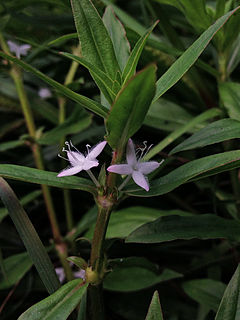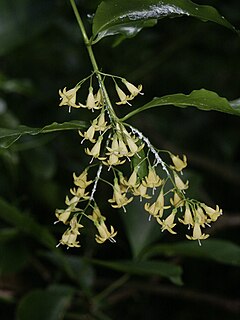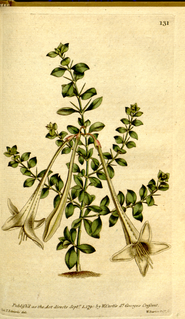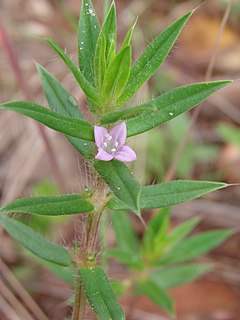
Diodia is a genus of flowering plants in the family Rubiaceae. It was described by Carl Linnaeus in 1753. The genus is found from southern and eastern United States, South America, Central America, Mexico, the West Indies and tropical Africa.
Bonania is a plant genus of the family Euphorbiaceae first described as a genus in 1850. It is native to the West Indies.
- Bonania cubanaA.Rich. - Bahamas, Cuba
- Bonania domingensis(Urb.) Urb. - Haiti, Dominican Rep
- Bonania ellipticaUrb. - Cuba
- Bonania emarginataC.Wright ex Griseb. - Cuba
- Bonania erythrosperma(Griseb.) Benth. & Hook.f. ex B.D.Jacks. - Cuba
- Bonania linearifoliaUrb. & Ekman - Haiti
- †Bonania myricifolia(Griseb.) Benth. & Hook.f. - Guantánamo but extinct

Pimenta is a genus of flowering plants in the myrtle family, Myrtaceae described as a genus in 1821. It is native to Central and South America, Mexico, and the West Indies.

Sideroxylon is a genus of trees in the family Sapotaceae described as a genus by Linnaeus in 1753. They are collectively known as bully trees. The generic name is derived from the Greek words σιδηρος (sideros), meaning "iron", and ξύλον (xylon), meaning "wood."

Erik Leonard Ekman was a Swedish botanist and explorer.

Exostema is a genus of flowering plants in the family Rubiaceae. It consists of trees and shrubs, endemic to the neotropics, with most of the species occurring in the West Indies.

Chaptalia is a genus of flowering plants in the family Asteraceae.

Chiococca is a genus of flowering plants in the family Rubiaceae. It currently holds 23 species that are native to Florida, Texas, Mexico, Central America, much of South America, the West Indies, and the islands of Galápagos and Fernando de Noronha.
Chione is a monotypic genus of flowering plants in the family Rubiaceae containing the single species Chione venosa. It is native to the neotropics, occurring in most of Mexico, and throughout Central America, the Caribbean, Colombia, Ecuador, and Peru. It is typically a tree growing 10 to 20 meters tall. In harsh habitats, it may be dwarfed and shrubby. It has no known economic use.

Catesbaea is a genus of flowering plants in the family Rubiaceae. It occurs in the West Indies, The Bahamas, and the Florida Keys. The genus is named in honour of English naturalist Mark Catesby.

Rondeletieae is a tribe of flowering plants in the family Rubiaceae and contains about 178 species in 8 genera. Its representatives are found from southern Mexico to northern South America and in the Caribbean.

Diodella is a genus of flowering plants in the family Rubiaceae. The genus has a wide distribution range and is found from the USA to tropical America and in tropical Africa.
Colleteria is a genus of flowering plants in the family Rubiaceae. The genus is found in the Caribbean.

Thouinia is a genus of flowering plants in the family Sapindaceae. The genus is named for André Thouin, a French botanist. As of 2020 Kew's Plants of the World Online lists 27 species in the genus:
Casasia haitensis is a species of plant that is native to Haiti. It belongs to the family Rubiaceae.
Torralbasia is a monotypic genus of flowering plants belonging to the family Celastraceae. It only contains the one known species, Torralbasia cuneifolia(C.Wright ex A.Gray) Krug & Urb.
Stevensia is a genus of flowering plants belonging to the family Rubiaceae.
Ottoschmidtia is a monotypic genus of flowering plants belonging to the family Rubiaceae. It only contains one known species, Ottoschmidtia microphylla(Griseb.) Urb.











